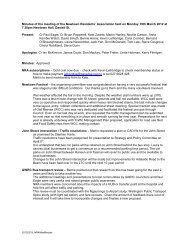Draft Town Belt Management Plan - Wellington City Council
Draft Town Belt Management Plan - Wellington City Council
Draft Town Belt Management Plan - Wellington City Council
You also want an ePaper? Increase the reach of your titles
YUMPU automatically turns print PDFs into web optimized ePapers that Google loves.
9.5.2 Signs<br />
176<br />
a. No signs or hoardings shall be permitted on <strong>Town</strong> <strong>Belt</strong> land that are not immediately<br />
relevant to the activities occurring on, or features of, the reserve. This includes election<br />
hoardings and any commercial advertising.<br />
b. The size, location, design and appearance of signs and sponsorship information must<br />
not detract from the amenity of the area nor appear to dominate other public<br />
information signs. All signs must comply with the legislative requirements, District<br />
<strong>Plan</strong> and Leases Policy where relevant.<br />
c. In general, the use of <strong>Town</strong> <strong>Belt</strong> land for advertising purposes shall be prohibited.<br />
However, existing and future sponsorship advertising relating to sportsfields and<br />
events shall only be permitted where:<br />
• the wording of the sign is readable only from within the area concerned and the<br />
structure supporting the advertising is sited as unobtrusively as possible<br />
• sponsorship signs are proposed on a building, the name of the sponsor must be<br />
incorporated into the external name signs for buildings rather than as a separate<br />
sign<br />
• the <strong>Council</strong> has the right to refuse permission for the display of any sponsorship<br />
or advertising material that may offend any section of the community.<br />
d. Temporary signs relating to special events will require permission as part of an event<br />
permit application and assessment.<br />
9.5.3 Community Gardens and Orchards. In considering a request to establish a community<br />
garden on <strong>Council</strong>-owned public land, the following criteria will be considered (based on<br />
<strong>Wellington</strong> <strong>City</strong> <strong>Council</strong> Guidelines for Community Gardens – September 2009):<br />
a. <strong>Wellington</strong> <strong>City</strong> will seek to maintain the public use and open space values of the land<br />
in accordance with the policies in this plan.<br />
b. Alternative open spaces, such as schools, vacant or temporary lots, and community<br />
housing have been considered.<br />
c. The location of community gardens within the <strong>Town</strong> <strong>Belt</strong> should consider and<br />
complement the primary function of the <strong>Town</strong> <strong>Belt</strong> and its associated uses and users 43 .<br />
d. Community gardens should be located to minimise potential conflict with <strong>Town</strong> <strong>Belt</strong><br />
uses and users.<br />
e. Community gardens should not dominate the primary usable area of local or<br />
community parks within the <strong>Town</strong> <strong>Belt</strong>.<br />
f. Community gardens must retain their public character and community gardens must<br />
be not-for-profit.<br />
g. Community gardens on <strong>Town</strong> <strong>Belt</strong> must follow the <strong>Wellington</strong> <strong>City</strong> <strong>Council</strong> Leases<br />
Policy for Community and Recreational Groups (2001).<br />
9.5.4 Utilities. Use of the <strong>Town</strong> <strong>Belt</strong> for public utilities is considered appropriate in some<br />
circumstances. This does not mean that the utility must be in public ownership, but it must<br />
provide an essential service to the public. All new utilities, and all replacements and<br />
upgrading of existing utilities, will be allowed on the <strong>Town</strong> <strong>Belt</strong> only where the <strong>Council</strong>'s<br />
specific conditions have been met (see policies below):<br />
a. New utilities, replacement or upgrading of existing utilities may be permitted by<br />
granting leases or easements provided it is an essential service to the public, it cannot<br />
be reasonably located elsewhere, the recreational nature of the <strong>Town</strong> <strong>Belt</strong> is not<br />
significantly disturbed, and where the public benefits outweigh any adverse impacts on<br />
this recreational nature. ‘Recreational nature’ means such features as the openness, the<br />
43 The <strong>Town</strong> <strong>Belt</strong> does not have one primary function as such, but the intent of this point is to ensure that any community<br />
garden development considers and complements the ecological and recreation roles of the <strong>Town</strong> <strong>Belt</strong>.<br />
<strong>Draft</strong> <strong>Town</strong> <strong>Belt</strong> <strong>Management</strong> <strong>Plan</strong> October 2012





